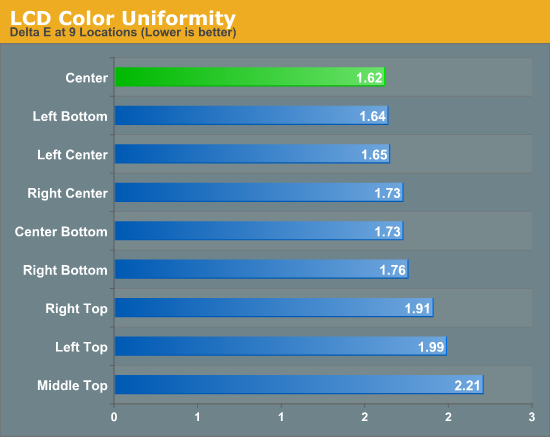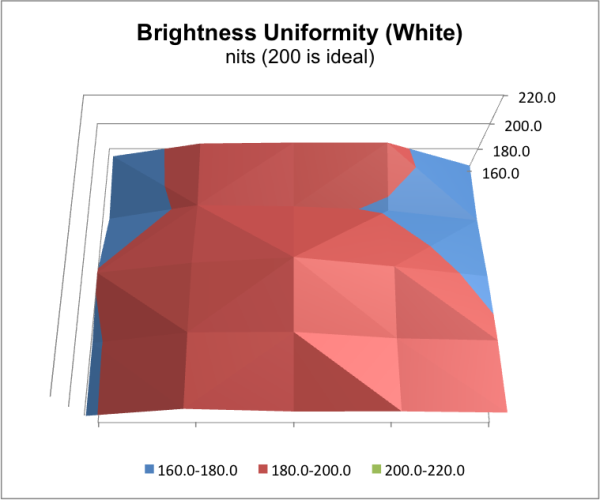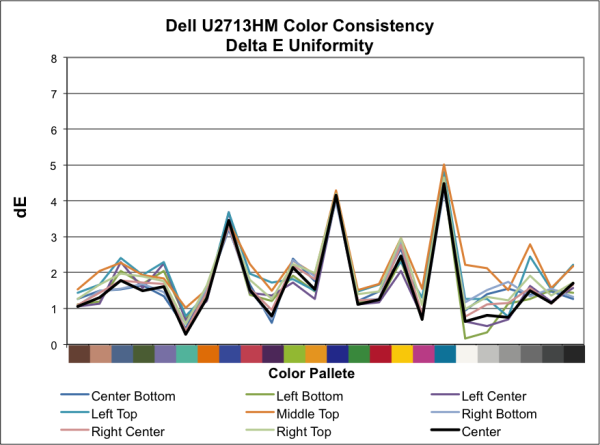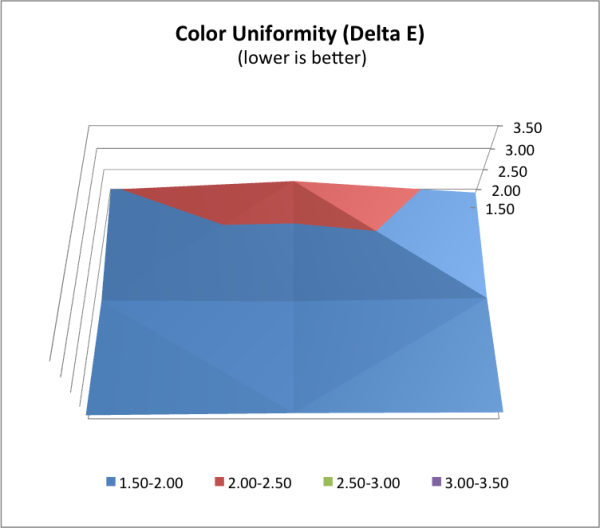Dell U2713HM - Unbeatable performance out of the box
by Chris Heinonen on October 4, 2012 12:00 AM ESTDell U2713HM Display Uniformity
Where our new ANSI testing will really pay off is on the Display Uniformity testing. It gives us far more information for how uniform the brightness and contrast levels are for a screen, as nine points is a fairly coarse measure on a screen of this size. Looking at the Dell I can see some small hints of backlight bleeding at the corners with an all-black screen, and when you look at the black levels you can see that seems to be the case.
The minimum black level at our calibrated 200 nits setting is 0.198 in the center, once again very close to that 1000:1 contrast ratio we saw before. This drops down to 0.175 and 0.182 in two corners, and rises up to 0.233 and 0.247 in other corners, indicating a bit of backlighting uniformity issues. The central area of the display (the inner nine squares in the ANSI pattern) is +/- 11% relative to the center square, but the outer edge goes all the way to +/- 25% compared to the center. Those two corners really push the level up and lead to this unevenness.
The white uniformity is better, though not ideal. With the center at 198 nits (we aim for 200 nits, but usually are just off), the middle nine squares are +/- 10% relative to it, which means a drop down to 178 nits just adjacent to the center. On the outer edge it falls to +/- 17% with the same corners causing the main issues here. With those same corners also being darker here, where they were lighter with the dark samples, I think this is more a uniformity issue than a corner bleed issue. The white uniformity here is fine but not stellar.
The contrast uniformity basically reflects what we discussed above. The center of the screen and most of the surrounding samples all have a contrast ratio of close to 1000:1, but three of the corners (all except the upper-left) have contrast ratios closer to 700 or 800:1 due to the lack of backlight uniformity. Now this is still better than some other 27” displays, but on full screen images such as gaming the difference could be noticeable. Overall the contrast ratios are still very good, with 16 of the 25 measured areas scoring at least 950:1 or greater.
The dE uniformity of the panel is a completely different matter it seems. I only measured nine spots here, as measuring 25 on this is not as easy to pull off or quite as essential I feel, but the results are very different. On the black and white uniformity tests, the center top area of the monitor always performed well, with deviations of 2% for black and 7% for white. With the color dE it is the single worst performing area of the screen, coming in with an average dE of 2.21 compared to the center where it’s 1.62. The lower left corner, which is the worst in black and white uniformity, is the best area outside of the center in dE uniformity.

So here it seems that brightness uniformity and color uniformity don’t go hand-in-hand all the time. It could be because of the different grid sizes, but that wasn’t what I saw before. More likely I just have results that don’t quite line up, or the cause of one is independent of the cause of the other. Either way, the dE uniformity isn’t perfect, but other than that one spot it remains below 2.0 for the rest of the screen and is a very good performer.















101 Comments
View All Comments
Gothmoth - Thursday, October 4, 2012 - link
yeah that´s bad.. i currentyl have 3 samsung 24 inch displays.during the three year warranty i send one of them in 3 times the other 2 times for repair.
defective powerboard each time. if they die again im out of luck.
that´s why i am frightened to buy expensive gear.
it will only last for the warranty period.... :(
peterfares - Thursday, October 4, 2012 - link
Did you fix it according to the directions on that site? Seems like an easy fix, just need to change out one large through-hole component.layte - Friday, October 5, 2012 - link
I have the parts arriving shortly. Looks like getting into it will be just as difficult as the soldering job.seapeople - Monday, October 8, 2012 - link
Dell's customer service is great considering you have reasonable expectations.Did your Dell equipment break while in warranty? If so, then call Dell, *boom* they give you a new one, and if they don't have that model, they give you the newer version of that model.
Did your Dell equipment break while not in warranty? If so, then you're on your own. If that bothers you, then buy the extended warranty, or otherwise buy something you can afford to replace on the chance it breaks out of warranty.
ajp_anton - Thursday, October 4, 2012 - link
The reviewed monitor is gone in the processing lag chart, unless it's name was changed to the U2412 which has the correct value from the chart above.For power usage, "Even with the backlight at maximum and the screen pure white".
Normally in TN panels a black pixel uses slightly more power than a white one (how negligible is this btw?). Is it different for IPS, or have they changed it?
mczak - Thursday, October 4, 2012 - link
Yeah this is indeed reversed for both VA and IPS in theory (TN needs active transistor to block light, VA and IPS need active transistor to let light through - this is also the reason dead pixels are more likely to be always lit with TN but always black with IPS/VA).That said though the difference should be pretty minimal - if you'd have a dynamic backlight that would far outweigh such effects.
TheManWithThePlan - Thursday, October 4, 2012 - link
This monitor seems to have worse calibration out of the box. The U2711 review had an uncalibrated 2.24 DeltaE.http://www.anandtech.com/show/2922/3
Have the testing methodologies changed or are the monitors objectively worse measuring?
cheinonen - Thursday, October 4, 2012 - link
Almost all previous models were measured using a XR Pro or an i1Display2, which are colorimeters that are subject to drift over time, and inherently not as accurate as a spectrometer. They also have issues with non-traditional CCFL lighting, which can include wide gamut CCFL, LED, and OLED. Last year I moved all display reviews to use an i1Pro spectrometer, which does not have these issues at all and is NIST certified to have a maximum error of 1.0 dE across the spectrum.The i1Pro isn't as good at measuring minimum black levels so for those I use an i1DisplayPro or C6 colorimeter, as we are only measuring luminance and not dE values. The move to the i1Pro also means that we have numbers that are more accurate, but not subject to direct comparisons with older measurements. I did some testing of the i1Display2 to the i1Pro, and they could have a difference of over 10 dE with the same pattern, so some values could be off. Using an i1Display2 is better than using nothing, but I trust the i1Pro numbers from the past year more than anything else.
rickon66 - Thursday, October 4, 2012 - link
Folks keep comparing this to no name Korean monitors where you have to "roll the dice" to see if you have a god one. This has a 3 year warranty and in my experience with several premium Dell monitors-if anything goes wrong with it a new monitor will appear at your door within 24-48 hours. This is a deal if you can get it at $559.Despoiler - Thursday, October 4, 2012 - link
$559 in Australia.